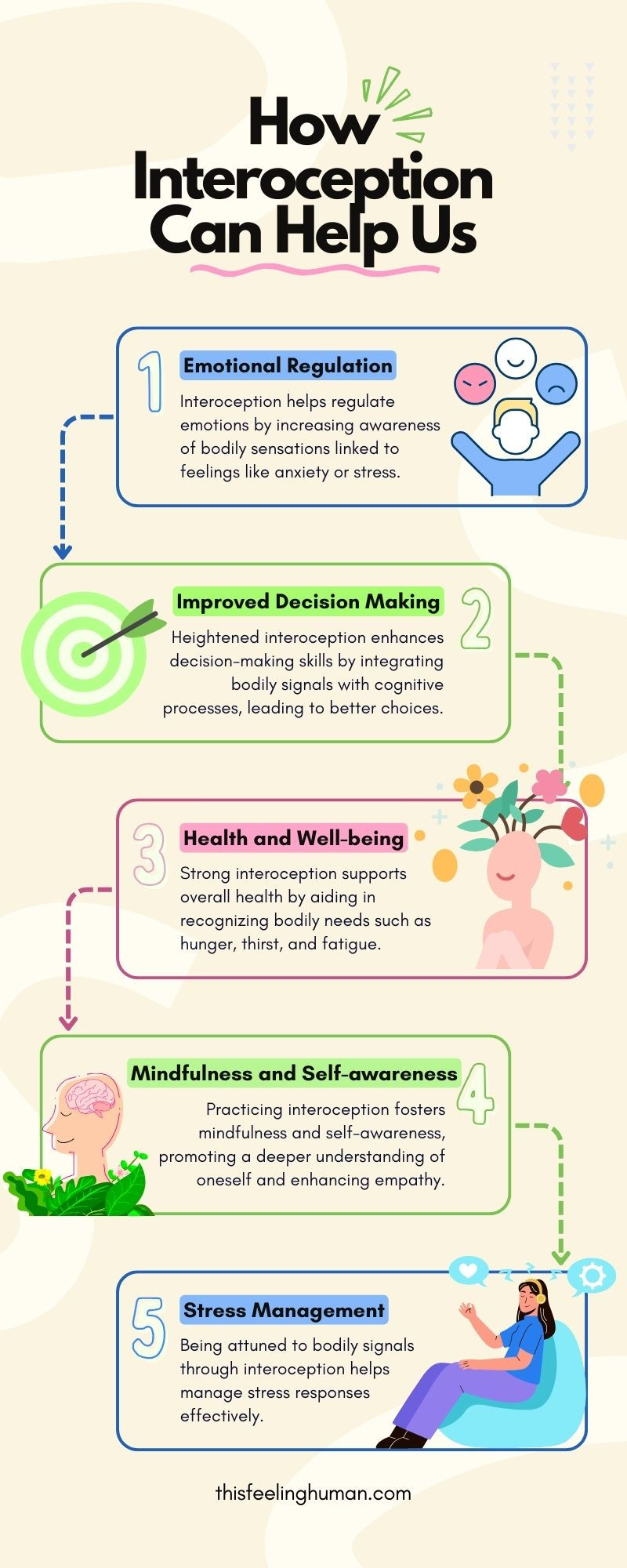Interoception and Emotional Perception | Bridging Body and Mind
- TFH
- Jun 19, 2024
- 4 min read
Updated: Aug 7, 2024
In the first part of the interoception, we explored the mechanisms of interoception and its role in emotional experience. In this second part, we will delve deeper into how interoception can help us, how it contributes to emotional perception and its practical implications for therapy, health, and daily life.
Contribution to Emotional Perception
Understanding the contribution of interoception to emotional perception involves recognizing how internal signals shape our emotional experiences and interactions. Contextualizing emotions with interoceptive signals—such as acknowledging that irritability may stem from hunger—can help us reframe emotional experiences, prevent misunderstandings, and enhance emotional self-awareness. This contextual insight allows for more accurate emotional perception and understanding of their origins.

Moreover, interoception plays a crucial role in social and empathic processes. By being aware of our internal states, we improve our ability to perceive and empathize with others' emotions. Mirror neurons and the brain's empathic circuits use interoceptive signals to simulate and understand others' feelings, fostering social bonding and empathy.
To support these insights, we’ve collaborated with The School of Emotions to promote their Emoli Cards, which assist individuals in exploring and interpreting their emotions. Our Emotions-Based Coaching bundle, featuring a life coaching session and a year's subscription to Calm3D's immersive emotional regulation tool, provides comprehensive support for developing emotional literacy and empathy.
Explore our bundled promotion here to discover how these resources can enhance your emotional understanding.
How Interoception Can Help Us

By understanding and enhancing interoception, we can improve our emotional and physical well-being. Here’s how interoception can help us lead healthier, more balanced lives.
1. Emotional Regulation
- Interoception helps regulate emotions by increasing awareness of bodily sensations linked to feelings like anxiety or stress.
2. Improved Decision Making
- Heightened interoception enhances decision-making skills by integrating bodily signals with cognitive processes, leading to better choices.
3. Health and Well-being
- Strong interoception supports overall health by aiding in recognizing bodily needs such as hunger, thirst, and fatigue.
4. Mindfulness and Self-awareness
- Practicing interoception fosters mindfulness and self-awareness, promoting a deeper understanding of oneself and enhancing empathy.
5. Stress Management
- Being attuned to bodily signals through interoception helps manage stress responses effectively.
Practical Implications
1. Therapeutic Interventions
Enhancing interoceptive awareness can be beneficial in various therapeutic contexts. Treatments for anxiety, depression, and eating disorders often incorporate techniques to improve interoception. Mindfulness practices, body awareness exercises, and biofeedback are commonly used methods. By improving interoceptive awareness, individuals can better recognize and regulate their emotional responses, leading to improved mental health outcomes.
2. Health and Well-being
Improved interoceptive awareness can lead to better self-care and overall health outcomes. By becoming more attuned to internal bodily signals, individuals can recognize and respond to their bodily needs more effectively, such as eating when hungry or resting when tired. This heightened awareness can also enhance emotional intelligence, leading to better relationships and social interactions.
3. Enhancing Emotional Intelligence
Emotional intelligence involves recognizing, understanding, and managing our own emotions and those of others. Interoception plays a crucial role in this process by providing insight into our internal emotional landscape. By improving interoceptive skills, individuals can enhance their emotional intelligence, leading to better personal and professional relationships.
Embracing Our Role as Architects to Shape Our Emotional World
Lisa Feldman Barrett’s book, "How Emotions Are Made," challenged us to rethink emotions not as these hardwired circuits but as something we actively construct. It’s a liberating concept because it means we’re not at the mercy of some ancient, animalistic brain—we’re architects of our emotional experience.
Think about it: our emotions aren’t fixed or predetermined. They’re fluid and adaptable, shaped by our unique experiences, culture, and the stories we tell ourselves. This perspective invites us to take charge—to become conscious creators of how we feel and how we respond to life’s ups and downs.
So, how do we become these architects of our emotions? It starts with awareness. Paying attention to our thoughts, our body’s signals, and the subtle shifts in our feelings. It’s about tuning in like you’re deciphering a secret language that only you understand.

Mindfulness practices have been a game-changer. Taking a few minutes each day to sit quietly, to breathe deeply, and to observe our thoughts without judgment will help us untangle the mess of emotions that used to overwhelm us. It’s like we’ve discovered a whole new level of self-awareness and inner strength.
But it’s not just about sitting still. It’s about living intentionally. Choosing how we react in challenging situations. Asking ourselves, “What story am I telling myself right now? Is this emotion serving me, or is there a different way I can respond?”
And let’s be real—it’s a journey. Some days we will feel like we’ve got it all figured out, and other days we stumble and fall. But that’s okay. Understanding that emotions are not these fixed, unchangeable things gives us hope. It means we can grow. We can learn. We can evolve into the best version of ourselves.
Practicing emotional resilience isn’t just about us, though. It’s about how we show up in our relationships, our work, and our community. It’s about bringing empathy and understanding into every interaction, knowing that everyone else is navigating their emotional landscape too.
So, let’s embrace this power we have—to shape our emotional world with intention and compassion. Let’s lean into the messy, beautiful complexity of being human. And let’s remember, we’re not alone on this journey. We’re all figuring it out together, one emotion at a time.
Conclusion
Interoception bridges the gap between our bodily states and emotional experiences, playing a crucial role in how we perceive and regulate emotions. By understanding and improving our interoceptive abilities, we can enhance both our emotional and physical well-being. Whether through therapeutic interventions or daily mindfulness practices, fostering a strong sense of interoception can lead to a healthier, more balanced life.
Comments